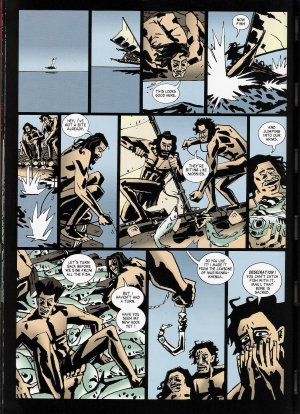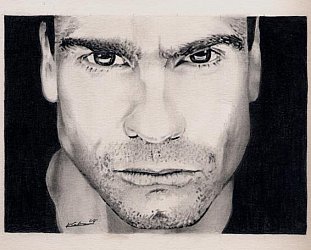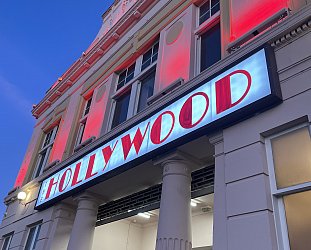Graham Reid | | 3 min read

There's the old observation that for most people history began with the first thing they remember, like in Billy Joel's song We Didn't Start the Fire which is just a baby-boomer litany of names and events which push emotional buttons.
Clearly Joel was of the persuasion that his generation did start the fire.
You would however be forgiven for thinking not much in the way of New Zealand comic book art existed before, ohh, maybe the Fifties . . . but that's because of the paucity of research and popular culture references to any older styles.
In that regard writer, researcher and cartoonist Adrian Kinnaird -- curently working on his first graphic novel -- has done us all a very big favour with this beautifully illustrated and produced stake in the ground on the subject of comic book art.
And as he concedes in his postscript, by the very breadth of this subject -- which he acknowledges doesn't mention Footrot Flats for reasons he explains -- means there is plenty more work for others to do, detours to explore ("let's not even get started on political cartoonists!") and definitions to debate.
But what Kinnaird has done in the first third of these 400-plus pages is to offer a broad hisorical outline of New Zealand's very interesting engagement with, and contribution to, the comic book form from the start of the 20th century.
Kinnaird's focus is on comic books (not strips, although invariably they do get a mention in passing where relevant) and he starts with a fascinating section on pioneers (1900-1940) which introduces Noel Cook ("one of our early comic exports" to Sydney) and notes a couple of signifcant women, notably Avis Acres and painter Rita Angus who worked in the field.
Cook's life is given a separate section -- he was quite the survivor -- but it does seem a pity that here, and in a number of subsequent pages, this historic art is reproduced too small (quarter page) for us to get a real feel for the work and skill.
As with many artists at the same time, many early New Zealand comic artists were seduced by adventure stories and "the future" (space ships, ray guns, men on the moon) but there were also a number of early examples of local artists using Maori and Maoriland as their characters/themes. Not always in ways that might sit comfortably today, but they were people of their period.
Kinnaird sketches all this in with prose which is pointed and concise, and he frequently returns to a number of the artists in more depth.
After "the wasteland" of the Sixties and early Seventies, the story of local comics really takes off with artists and enthusiasts such as Barry Linton, Lawrence Clark, Chris Knox, Dylan Horrocks, Cornelius Stone and more whose names would be familiar from magazines like Strips, Jesus on a Stick and others.
It is also good to be reminded of the heroic eco-warrior Captain Sunshine (by Colin Wilson with assistance from Clark, Joe Wylie, Jean-Luc Bozzoli and others). In 1979 it sold 100,000 copies and because of the sheer beauty of the artwork you could guess many of those copies are still on shelves in people's homes today. It is on mine.
The story of New Zeaand comic artists moves through Roger Langridge, Martin Emond, Chris Cudby and others -- with special attention to Horrocks, Emond and Ant Sang -- and then into graphic novels such as the enormously popular Terry and the Gunrunners which was made into a successful television series with actual actors working in a cartoon manner and the storyline intercut with animated sections. (See here)
The central section of the book showcases 30 artists whose work is given full and multiple page treatment with potted biographies. Here you might note however that the focus is on more contemporary artists, who didn't really start the fire.
At this point, despite space constraints, it might have included a couple of those ancestors whose detailed work doesn't get the same consideration in the early pages.
 The fnal third is more themed: Dylan Horrocks and Emily Perkins' collaboration (of mixed success); Dick Frizzell; New Zealand Comics and Film; and in the studio with Ant Sang.
The fnal third is more themed: Dylan Horrocks and Emily Perkins' collaboration (of mixed success); Dick Frizzell; New Zealand Comics and Film; and in the studio with Ant Sang.
Of these, the Film/Comic section stretches the point to focus on filmmaker and artist Vincent Ward who -- although having grown up on comics -- hasn't made an animated feature. Left out of this discussion are Wylie who has, and perhaps this might have been the place to consider in greater depth Terry and the Gunrunners by Stephen Ballantyne and Bob Kerr which made a fascinating film treatment.
Or even the relationship between the art and animation in the '87 Grammy-nominated The Frog The Dog and the Devil by Bob Stenhouse, Hugh McDonald and Martin Townshend (see here).
But given how porous the barrier is between comics, film and animated features, Kinnaird doubtless had to seal his subject off somewhere and these pages are chock full of pointers for further investigation, history, characters (real and animated) and some wonderful artwork, not the least being Chris Slane and Robert Sullivan's innovative '96 graphic novel Maui: Legends of the Outcast (above).
Kinnaird has done many of these artists a great service in putting their often ephemeral work back into the conversation again, and on these pages some of them live again.
Dylan Horrocks' Hicksville graphic novel is essayed here and he is interviewed here.
From Earth's End; The Best of New Zealand Comics by Adrian Kinnaird. Published by Godwit/Random House $60





post a comment